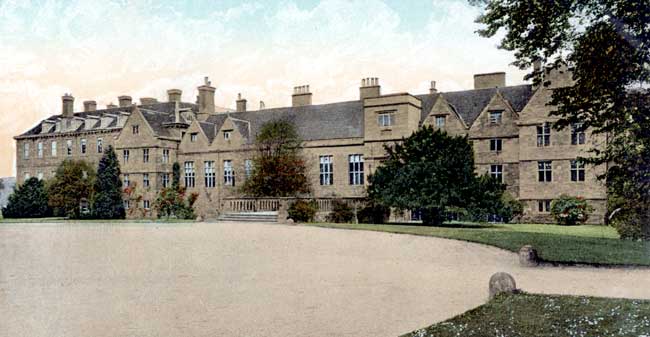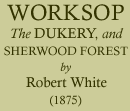< Previous | Contents | Next >
![]()
Rufford Abbey

The west front of Rufford Abbey, c.1905.
THIS fine rural liberty was anciently called Rugforde or Ruinforde. Before the Conquest it was held by Ulf the Saxon, and afterwards was of the fee of Gilbert le Gant, nephew to the Conqueror. This Gilbert le Gant was succeeded by his son Walter,whose eldest son, Gilbert, married the Countess of Lincoln, and was himself created Earl of Lincoln. Here, in 1148, he founded a Cistercian Abbey, in honour of the Virgin Mary, for a colony of monks whom he brought from the abbey of Rievaulx, in Yorkshire. The name of Sir Philip de Ryme the first Abbot appears as a witness to a charter of Gilbert, Earl of Lincoln, to Pontefract monastery. From the foundation to the dissolution there were 17 Abbots, the last of whom was Thomas Doncaster. At the dissolution, the Abbey contained 15 monks whose revenues amounted to £254 6s. 8d. After their expulsion Henry VIII. granted the Abbey and estate to Sir John Markham, for 21 years, at £22 8s. 0d. per annum: afterwards, with the manor of Rotherham which had previously belonged to the Abbey, and with much other property, he gave it to George, fourth Earl of Shrewsbury and Waterford, in exchange for many large estates in Ireland, and in consideration of the prompt measures he adopted to suppress the rebellion in the north, known as the "Pilgrimage of Grace."
Rufford became an occasional residence of this noble family, and it was here that the celebrated Bess of Hardwick, with her usual ambitious scheming, brought about a hasty marriage between her daughter Elizabeth and Charles Stuart, younger brother of Darnley, the father of James 1st. Charles was travelling towards Scotland in 1574, with his mother, the Countess of Lennox; the latter being somewhat indisposed, they were prevailed on by Bess to rest a few days at Rufford, when the above-mentioned wedding took place. This marriage gave great offence to Queen Elizabeth, and the two mothers were in consequence committed to the Tower, but were afterwards released. In the meantime the young Countess of Lennox became the mother of the ill-fated Arabella Stuart, whose near proximity to the Crown was the cause of a life of persecution and woe.
With reference to this affair the following amusing letter was written by the Earl of Shrewsbury, the husband of Bess, to Lord Burghley, in which, though professing to treat the matter lightly, as he knew it would be otherwise looked upon by his jealous sovereign, he evidently tries to shift the burden from his own shoulders.
"The Lady Lennox being as I heard sickly, rested her at Rufford five days and kept most her bed-chamber, and in that time the young man her son fell into liking with my wife’s daughter before intended, and such liking was between them as my wife tells me she makes no doubt of a match, and bath so tied themselves upon their own liking as cannot part. My wife hath sent him to my lady, and the young man is so far in love that belike he is sick without her. This taking effect, I shall be well at quiet, for there is few noblemen’s sons in England that she bath not prayed me to deal for at one time or other, and now this comes unlooked for without thanks to me."
Mary, the wife of Gilbert, Earl of Shrewsbury and daughter of Bess of Hardwick, resided at Rufford in her widowhood,e and the estate passed into that family by the marriage of her sister-in-law, Lady Mary Talbot, with Sir George Savile, of Barrowby, Lincolnshire. Sir George was succeeded by his grandson of the same name, his eldest son, Sir George, who married Anne, daughter of Sir William Wentworth, of Wentworth Woodhouse, and sister to the first Earl of Strafford, having died before him. Sir George Savile, second Baronet, died unmarried in his minority, and was succeeded by his brother, Sir William Savile, the royalist general commander, who married Anne, daughter of Thomas, Lord Keeper Coventry. This lady was noted for her courage and resolution during the civil wars, especially at the siege of Sheffield Castle, where she remained for security after her husband’s death, which had taken place six months before the siege.
Lady Savile’s case was peculiarly distressing, for we are told by Dr. P. Barwick in the life of his brother, the Dean of St. Paul’s, that "this gallant lady, famous even for her warlike actions beyond her sex, had been besieged by the rebels in Sheffield Castle, which they battered on all sides by great guns, tho’ she was big with child, and had so little regard for her sex, that in that condition they refused a midwife she had sent for, the liberty of going to her. Yet this unheard-of barbarity was so far from moving her that she resolved to perish rather than surrender the castle. But the walls being every where full of cracks with age, and ready. to fall, the soldiers of the garrison began to mutiny, not so much concerned for their own danger, as for the lamentable condition of this noble lady, so near the time of her falling in labour; for she was brought to bed the night after the castle was surrendered." She was the mother of Sir George, fourth Baronet, afterwards created Marquis of Halifax.
This Sir George Savile, fourth Baronet, who enlarged Rufford, was created Marquis of Halifax, by King Charles II. in 1682; but that title became extinct on the death of his son William, in 1700, who left only three daughters, one of whom marrying Richard, Earl of Cork and Burlington, carried the Savile estates at Barrowby, Lincolnshire, to that family; whence they descended to her only daughter and heiress, Lady Charlotte Boyle, afterwards Duchess of Devonshire, in the possession of which family they still remain.
The Rufford estate then descended to the next male heir, Sir John Savile, the sixth Baronet, who dying unmarried in 1702, was succeeded by his cousin, Sir George Savile, the seventh Baronet, whose son, Sir George Savile, the eighth and last Baronet, died unmarried in 1784, and left his Irish estates and those at Brierley, in Yorkshire, to his niece, Mrs. Foljambe, of Osberton, the daughter and heir of his eldest sister, Arabella, who had married John ThornhaghHewitt, Esquire, of Osberton and Shireoaks, and those at Rufford and Thornhill to Richard, the second son of his younger sister, wife of the fourth Earl of Scarborough. On the death of his eldest brother in 1807, he succeeded to the Scarborough title and estate, while the estate of Rufford passed to his younger brother, the Honourable and Reverend John Lumley Savile, who in 1832 succeeded his eldest brother as Earl of Scarborough. He held both the Sandbeck and Rufford estates till his death in 1835, and was succeeded by his son, John Savile Lumley Savile, the eighth Earl of Scarborough, Viscount and Baron Lumley, and also Viscount Lumley in Ireland; he dying in 1856, left it to his son, Henry Savile, Esquire, the present owner and occupier of Rufford Abbey.
